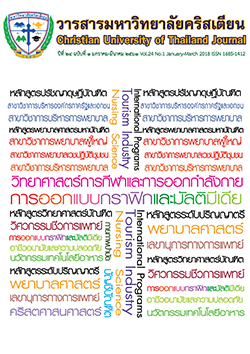ผลการใช้คอมพิวเตอร์ช่วยสอนภาษาในการเสริมสร้างความรู้ด้านคำศัพท์ของนักศึกษาระดับชั้นปีที่ 1 ในมหาวิทยาลัยเอกชนแห่งหนึ่งในจังหวัดนครปฐม
คำสำคัญ:
คอมพิวเตอร์ช่วยสอน, ความรู้ด้านคำศัพท์บทคัดย่อ
งานวิจัยนี้มีจุดประสงค์เพื่อศึกษาความสัมพันธ์ระหว่างการใช้โปรแกรมคอมพิวเตอร์ช่วยในการเรียนการสอนกับทักษะการเรียนรู้คำศัพท์ ผู้วิจัยได้ออกแบบการวิจัยแบบให้เป็นแบบการวิจัยกึ่งทดลองแก่นักศึกษาปริญญาตรี ชั้นปีที่ 1 ที่ลงทะเบียนเรียนวิชาภาษาอังกฤษ 3 จำนวน 20 คน ในการวิเคราะห์ผลทางสถิติของการทดสอบก่อนและหลังเรียน (Pre and Post-test) นั้นจะใช้ T-Test ในการวิเคราะห์ และแบบสำรวจความคิดเห็นของลิเกิต (Likert) ถูกนำมาใช้ในการสำรวจความคิดเห็นของผู้เข้าร่วม ในการใช้โปรแกรมคอมพิวเตอร์เข้ามาช่วยสอนนั้นจะทำการทดสอบก่อนเรียนจะใช้เวลา 1 ชั่วโมงในวันแรก และ 10 ชั่วโมง ภายใน 2 เดือน แต่การทดสอบหลังเรียนจัดทำ 1 ชั่วโมงในวันที่มีการเรียนวันสุดท้ายเท่านั้น ผลการทดลองโดยใช้เครื่องมือพบว่า ผลการทดสอบหลังเรียนนั้นมีค่าความแตกต่างทางสถิติอย่างมีนัยสำคัญอยู่ที่ 0.01 ซึ่งแสดงให้เห็นว่า นักศึกษามีการพัฒนาที่ดีขึ้นมากในด้านทักษะการเรียนรู้คำศัพท์ ในส่วนของการทดสอบทัศนคตินั้นจะเห็นได้ว่า ผู้เข้าร่วมการวิจัยมีทัศนคติที่ดีต่อการวิจัยตลอดโครงการ ดังนั้น ผลการวิจัยแสดงให้เห็นว่าการวิจัยครั้งนี้สอดคล้องกับการวิจัยครั้งก่อนหน้าที่ชี้ให้เห็นว่า การเรียนจากโปรแกรมคอมพิวเตอร์นั้นมีผลต่อการเรียนรู้และเพิ่มเติมคำศัพท์ภาษาอังกฤษของผู้เรียนจากการวิจัยครั้งนี้จึงเสนอแนะได้ว่า การใช้คอมพิวเตอร์เข้ามาช่วยในการเรียนการสอนนั้นมีส่วนช่วยให้ผู้เรียนสามารถเพิ่มพูนคำศัพท์จากการเรียนได้มากยิ่งขึ้น
เอกสารอ้างอิง
Beatty, K. (2003). Teaching and Researching Computer-Assisted Language Learning.London, Pearson Education.
Boonkongsaen, N. & Intraprasert, C. (2014). Use of English Vocabulary Learning Strategies by Thai Tertiary-level Students in Relations to Fields of Study and Language-learning Experiences. English Language Teaching, 7(5), 59-70.
Castro, R. (2015). The Effects of Using Structural and Contextual Analyses Strategy in Developing the Vocabulary Skill of Undergraduate Students at a Private University in Nakhon Pathom. Graduate School, Christian University of Thailand.
Dewan, G. (2013). Computer Assisted Vocabulary Learning Package for Nursing Students and their Learning Attitude. Prince of Songkla University. Master of Arts Degree in Teaching English as an International Language. Retrieved August 14, 2016,from http://kb.psu.ac.th/.
Egbert, J.L. (2005). Conducting research on CALL In J.L. Egbert & G.M. (Eds.).CALL research perspectives. Mahwah, NJ: Lawrence Erlbaum.
Khodaparast, F. & Ghafournia, N. (2015). The Effects of Asynchronous/Synchronous Approaches on English Vocabulary Achievement: A Study of Iranian EFL Learner,8(4), 117-127 Retrieved August 8, 2016, from www.eric.ed.gov.
Levy, M. (1997). Context and Conceptualization. Oxford: Oxford University Press.
Liangpanit, C. (2015). Vocabulary Learning Strategies for Thai Learners: Research to Practice.Journal of Humanities and Social Sciences. Thaksin University, 15(2), 119-131.
Motteram, G. (2013). Voices. The benefits of new technology in language learning.Retrieved August 5, 2016, from www.britishcouncil.com.
Sedita, J. (2005). Effective Vocabulary Instruction. Insights on Learning Disabilities, 2(1), 33-45.
Shao, J. (2012). A Study of Multimedia Application-based Vocabulary Acquisition. Canadian Center of Science and Education, 5(10), 202-207.
Stempleski, S. (2014). Stretch 2. Oxford University Press.
Suppasetseree, S. & Linh, N.D. (2016). The Development of an Instructional Design Model on Facebook Based Collaborative Learning to Enhance EFL Students' Writing Skills.IAFOR Journal of Language Learning, 2(1), https://doi.org/10.22492/ijll.2.1.04
Wilkins, D. (1972). Linguistics in Language Teaching. London: Arnold.



